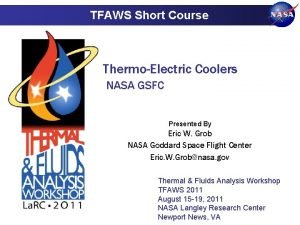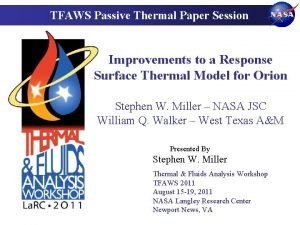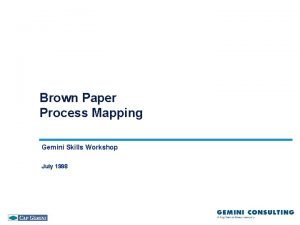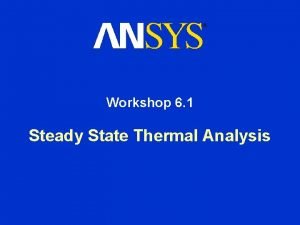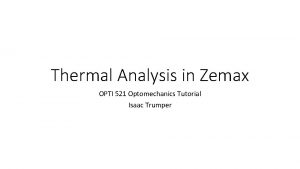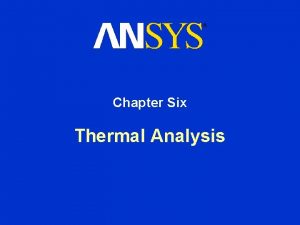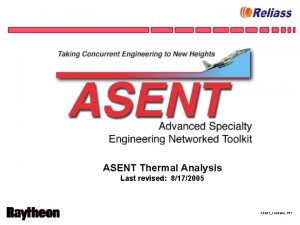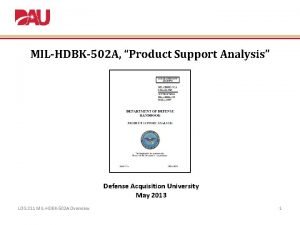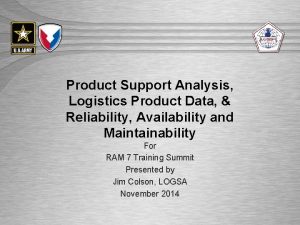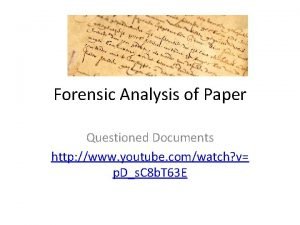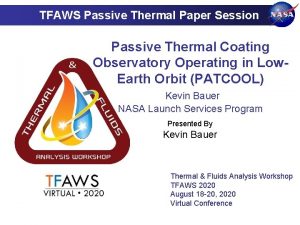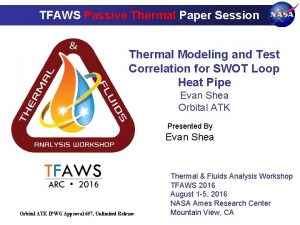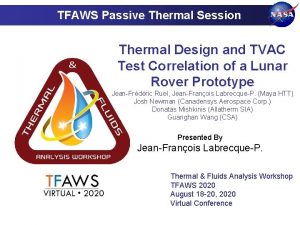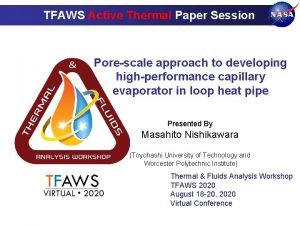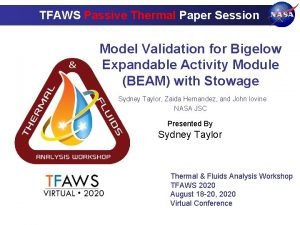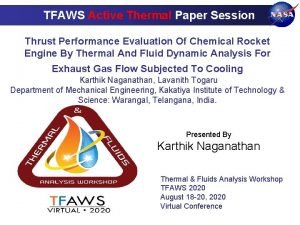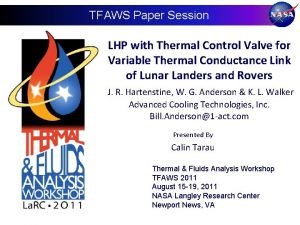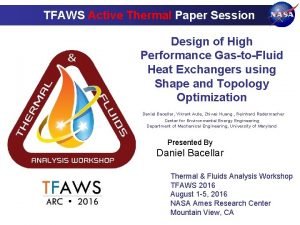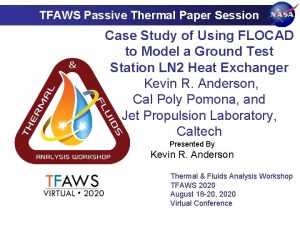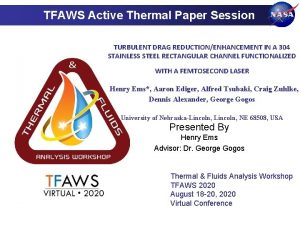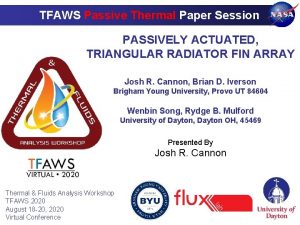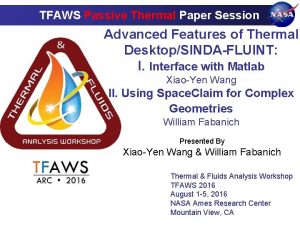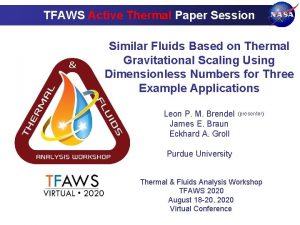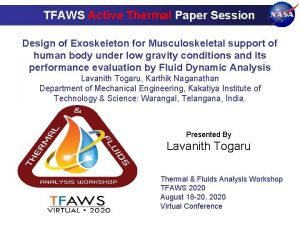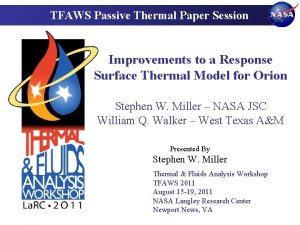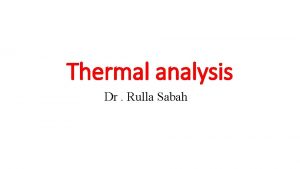TFAWS Paper Session Thermal Analysis in Support to



















- Slides: 19

TFAWS Paper Session Thermal Analysis in Support to Thermal Protection System Seals and Interface Design of IXV Lorenzo Andrioli, Massimo Antonacci Thales Alenia Space – Turin, Italy Alessandro Mannarelli SSE Sofiter System Engineering – Turin, Italy Presented By Lorenzo Andrioli Thermal & Fluids Analysis Workshop TFAWS 2011 August 15 -19, 2011 NASA Langley Research Center Newport News, VA

Outline • Introduction • Analysis Approach • Interfaces (I/F) Thermal Mathematical (TMMs) general description – – Models Thermal network basic concept Environment simulation Analysis work logic Model example • New approach for Thermal Protection System (TPS) thermal analysis • Summary & Conclusions TFAWS 2011 – August 15 -19, 2011 2

Introduction The IXV (Intermediate e. Xperimental Vehicle) • An atmospheric re-entry demonstrator which will perform a suborbital flight and will re-enter in the atmosphere. • To be launched by the ESA/Vega from the Centre Spatial Guyanais (CSG) • It will experience the typical Low Earth Orbit re-entry thermal loads. TFAWS 2011 – August 15 -19, 2011 3

Introduction Main objective: To develop an analytical approach to be implemented for I/F design of IXV. Model characteristics changes operated by means of: – algorithms – configurations To properly simulate behaviour of items characterized by different: – thermal properties – thermo-mechanical properties – permeability Leading to different temperature requirement limits. TFAWS 2011 – August 15 -19, 2011 4

Introduction Interfaces (I/F) External critical regions in which environmental agents can find a preferential way to dangerously affect internal environment and items. Design requirements: • to limit sneak flow and act as thermal barriers (proper sealing); • to limit discontinuities (steps, gaps, and bowing) in the vehicle Outer Mould Line; • to allow depressurization and repressurization of IXV and TPS&H/S Assemblies. TFAWS 2011 – August 15 -19, 2011 5

Introduction Different types of I/Fs to be designed: • among different-type Thermal Protection Systems: – – – nose-to-windward nose-to-leeward-to-windward-to-hinge-to-rear hinge-to-leeward • between TPSs and other subsystems: – – – floatation system ejectable panels insulation venting hole protection insulation over antennas bridle channels insulation protection insulation on umbilical mechanisms TFAWS 2011 – August 15 -19, 2011 6

Analysis Approach Modeling criterion • ESATAN Thermal Lumped Parameter (TLP) solver • Technique resembles System Thermal Mathematical Model (TMM) one improving temperature mapping capabilities • highly customizable 2 D mesh models and one 3 D axisymmetric model • depending on the I/F type, a fluid leak (sneak flow) through sealing materials is simulated TFAWS 2011 – August 15 -19, 2011 7

I/F TMMs general description Thermal network basic concept • Thermal network organized in node blocks linked together to establish a geometrical hierarchy → propagation of changes by acting upon relevant parameters (e. g. modification of items sizing, material properties, etc. ) • Node blocks wrapped into arithmetical nodes → spreading effect of surface heat exchanges implicitly solved (reliable evaluation of I/F temperatures) TFAWS 2011 – August 15 -19, 2011 8

I/F TMMs general description Environment simulation • Internal environment: radiative and convective equivalent conductors (representative nodes defined on the basis of System TMM) • External environment: radiative conductors and heat fluxes (ATDB, max heat load trajectory) or input from dedicated thermo-ablative software • Sneak flow: modelled by means of a heat contribution calculated as: TFAWS 2011 – August 15 -19, 2011 9

I/F TMMs general description Air mass flow: calculated with Darcy law 1 D formulation k permeability of the seal m air kinematic viscosity r air density th spatial term describing the flow path (seal thickness) p pressure A flow area (gap × slot width) Sneak flow into non-passing through slots: air filling the gap is considered as stagnating (really thin and deep slots, highly conservative boundary layer temperature) TFAWS 2011 – August 15 -19, 2011 10

I/F TMMs general description • Air flow through venting hole: equivalent thermal conductor (h × A) linking duct with a inflow boundary node kair rbush Nu air conductivity duct internal radius Nusselt number From Petukhov-Gnielinski semi-empiric correlation: TFAWS 2011 – August 15 -19, 2011 11

I/F TMMs general description Analysis work logic TFAWS 2011 – August 15 -19, 2011 12

I/F TMMs general description Model example: typical TPS-to-TPS junction I/F TFAWS 2011 – August 15 -19, 2011 13

Analysis results and their application Local vs System TMMs DT are applied to overall vehicle temperature maps all along the I/Fs envelope at C/S and TPS level. Temperature maps are used as an input for System Thermo-elastic analyses → overall steps and gaps requirements verification TFAWS 2011 – August 15 -19, 2011 14

New approach for TPS thermal analysis Current approach modeling (ESATAN) flaws: • ESATAN-TMS GUI is in early development phase → code is usually written down by hand • Manual debugging and subroutine generation is the rule → coding is more error-prone than a robust front-end approach • CAD interfacing tools are under development → geometry is user discretized and modeled, usually in scripting form with graphic visualization • Data exchange is manually managed by means of properly written routines → a coding endeavor is required TFAWS 2011 – August 15 -19, 2011 15

New approach for TPS thermal analysis Solution: switching to an hybrid approach tool. • Bi-directional from/to CAD geometry interfacing, with direct user intervention for simplification purposes • Finite element based model mesh generation • Possibility to chose between a Finite Element Method (FEM) or a TLP solution • Possibility to chose between FEM or TLP like postprocessing (temperatures interpolated over the node vs isothermal nodes) TFAWS 2011 – August 15 -19, 2011 16

New approach for TPS thermal analysis FEM-TLP hybrid workflow in NX environment An example of hybrid approach workflow applied to a preliminary TPS-to-TPS I/F analysis. TFAWS 2011 – August 15 -19, 2011 17

Summary & Conclusions The presented modelling approach has been developed in the frame of IXV programme resulting into a key feature of the I/F design assessment at System level. The adopted work logic resulted in an effective approach to: • Achieve the required detail level for I/Fs design justification • Reduce development times and iterations between the different disciplines involved • Minimize and enhance data exchange cycles among several analysis tools TFAWS 2011 – August 15 -19, 2011 18

Summary & Conclusions Improvements based on hybrid FEM/TLP analysis are being implemented to: • Boost up detail level for I/Fs design refinement • Further reduce development and coding endeavor (minimizing modeling mistakes) • Enhance data exchange among several CAD/analysis suites TFAWS 2011 – August 15 -19, 2011 19
 Nasa tfaws
Nasa tfaws Tfaws
Tfaws Section 3 using thermal energy worksheet answer key
Section 3 using thermal energy worksheet answer key Thermal transfer vs direct thermal printing
Thermal transfer vs direct thermal printing Brown paper workshop
Brown paper workshop Supporting details major and minor
Supporting details major and minor Aice english paper 2
Aice english paper 2 Aice general paper sample essay
Aice general paper sample essay Steady state thermal analysis
Steady state thermal analysis Factors affecting dta curve
Factors affecting dta curve Opti 521
Opti 521 Differential thermal analysis
Differential thermal analysis What is steady-state thermal analysis?
What is steady-state thermal analysis? Thermal analysis ppt
Thermal analysis ppt Dsc
Dsc Product support analysis psa
Product support analysis psa Logistics product data
Logistics product data Forensic analysis of paper
Forensic analysis of paper Session 0 windows
Session 0 windows Welcome to the new session
Welcome to the new session
